

| The Nottinghamshire distribution of the Minotaur Beetle |
| ... |
| The
Minotaur Beetle Typhaeus typhoeus (Linnaeus, 1758) is one of
the UK's most impressive beetles, with a large size and to make a
large beetle even more spectacular, the pronotum of the male is adorned
by large, forward-pointing horns. And for once, this is not one of those rare species
that you're hardly ever likely to
come across. That said, they are unlikely to be encountered digging up your back lawn, but they are easily found, fairly widespread and what makes it even better, is that when you find one, you don't have to be Usain Bolt to keep up with it, you don't need a net and you don't need a spade to go digging after one in the event of it starts to head down its burrow. Thankfully, Minotaur Beetles barely break out of a stop, and are usually to be found walking slowly across bare ground or short turf on the county's heathland sites, or other grassy sites which lie on shallow, sandy soils. If anything, it seems to have increased over the past decade or two and is usually common where it occurs. |
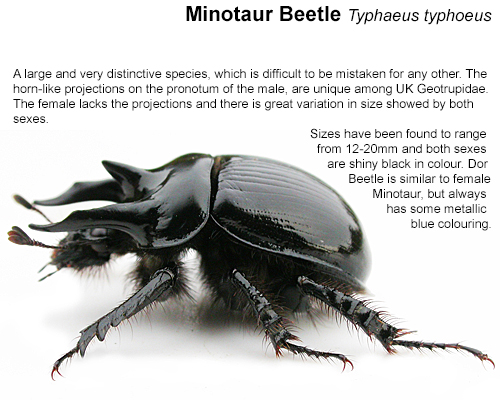 |
|
| .... | ||
|
Minotaur burrows, construction and egg production Whether the beetle itself is seen or not, Minotaur burrows are even more conspicuous and easy to identify, as yet again there is nothing in Nottinghamshire to create confusion.The burrow entrance is usually around 15mm wide and usually located near to a dung source. Following mating in the Spring, both male and female work together to construct a deep burrow, sometimes reaching a remarkable 1.5m depth. |
||
| ... | ||
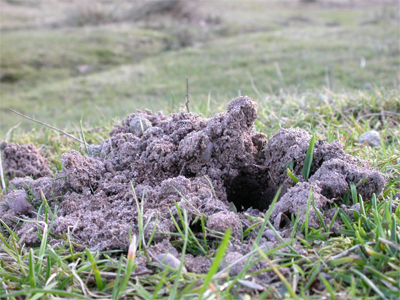 |
Branching off this main burrow are a
numberof short, lateral burrows. At the end of each burrow, an egg
is then deposited by the female. For such a large beetle, egg
amounts are very small, usually less than 20 eggs per female. Each
of these short burrows are then filled with dung by both sexes,
before being blocked off by sand or soil. Following the completion of the burrow and egg laying, the adults die by the Summer. The new generation of adults emerge from September and if the Autumn weather remains mild, burrow construction can begin before overwintering. Adults can occasionally be found collecting dung on mild Winter days, with highest activity always occurring at night whatever the time of year. The left hand photograph shows a typical Minotaur burrow entrance with spoil heap. Burrows are often constructed in close proximity, mostespecially on those sites where populations are high. It is possible that 'open' burrows of the Dor Beetle Geotrupes stercorarius, could be mistaken |
|
| ... | ||
|
Nottinghamshire distribution The Minotaur Beetle's current distribution in Nottinghamshire appears restricted to those sites lying on Sherwood Sandstone. The limits of Sherwood Sandstone across Nottinghamshire is shown in the map including geology below. At the moment, the Minotaur's Nottinghamshire range seems to be from Watchwood (on the A614 near Calverton) and Haywood Oaks about a mile north up the road from Watchwood. Both sites lie in central southern Nottinghamshire, pretty much where the Sherwood Sandstone geology widens. The beetle's present range continuing northwards through Sherwood Forest Golf Course and Strawberry Hill Heath, throughout Sherwood Forest to as far as Clumber Park. In all honesty, its probably more common on sandy soils than the current distribution map suggests. This proposal is supported by isolated sites at Wollaton Park in Nottingham, Barrow Hills (in north Nottinghamshire) and Spalford Warren in the east of the county, which is the only known site east of the River Trent. Its stronghold is the Sherwood Forest area, notably on heathland at Budby South Forest and Sherwood Heath near Ollerton and again on the A614. |
||
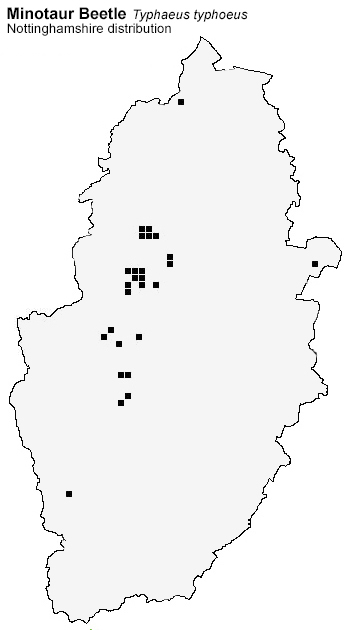 |
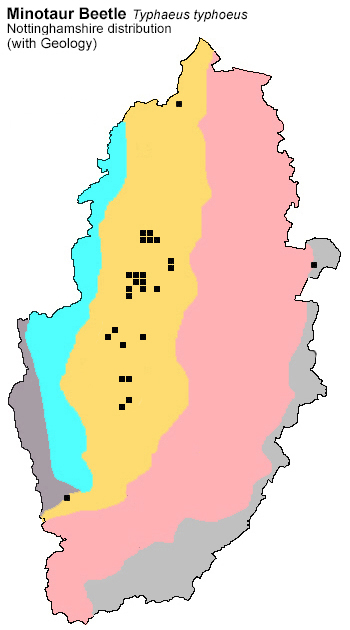 |
 |
| The Minotaur's Nottinghamshire range continues northwards through Sherwood Forest Golf Course and Strawberry Hill Heath, through the Sherwood Forest NNR to as far as the heathland areas of Clumber Park. In all honesty, it is probably more common on sandy soils than the current 1km squares on the distribution map suggests. This proposal is supported by known isolated Minotaur sites at Barrow Hills near Everton in north Nottinghamshire and Wigsley Wood (privately owned) in the east of the county, which is the only known site east of the River Trent. |
| ... | ||
| Its stronghold is
firmly entrenched in the Sherwood Forest area, most notably on
heathland at Budby South Forest and Sherwood Heath near Ollerton and
again, another site lying on the A614, which would almost appear to
act as a north/south barrier to many species showing a preference
for light, sandy soils. However, this just seems to be coincidental
with the A614 pretty much overlying the geological border between
Sherwood Sandstone becoming Mercia Mudstone. But it really should be more widespread (or perhaps it already is?) in the Clipstone Forest/Sherwood Pines area and those forested sites with at least some suitable habitat (and a source of dung) to the south and west of Mansfield in the Newstead Abbey area. But if it's present at Watchwood, then is it not further south in the county at sites such as Bestwood Golf Course, other than being present at Wollaton Park? From the records we built up over some 13 years, the Minotaur Beetle has yet to colonise any of the former colliery sites local to the Sherwood Forest area. Parts of the former Thoresby Colliery would seem to be the most likely of all the colliery sites to be colonised, as sandy topsoil has been added during post-closure landscaping. |
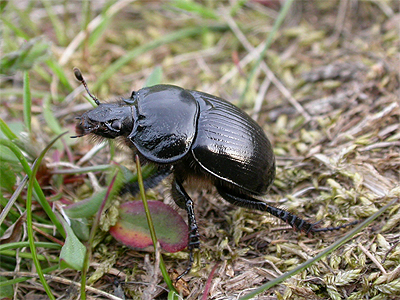 |
|
| ... | ||
| Geographically, Thoresby Colliery is the most ideally situated for Minotaurs to move in to, as it's directly located between the large Budby South Forest and Sherwood Heath Minotaur populations, not forgetting several other local sites holding smaller numbers. However, once the inevitable grazing of Thoresby's present habitat is introduced and dung becomes more plentiful, Minotaurs will undoubtedly turn up. | ||
| Beetles |
| Homepage |